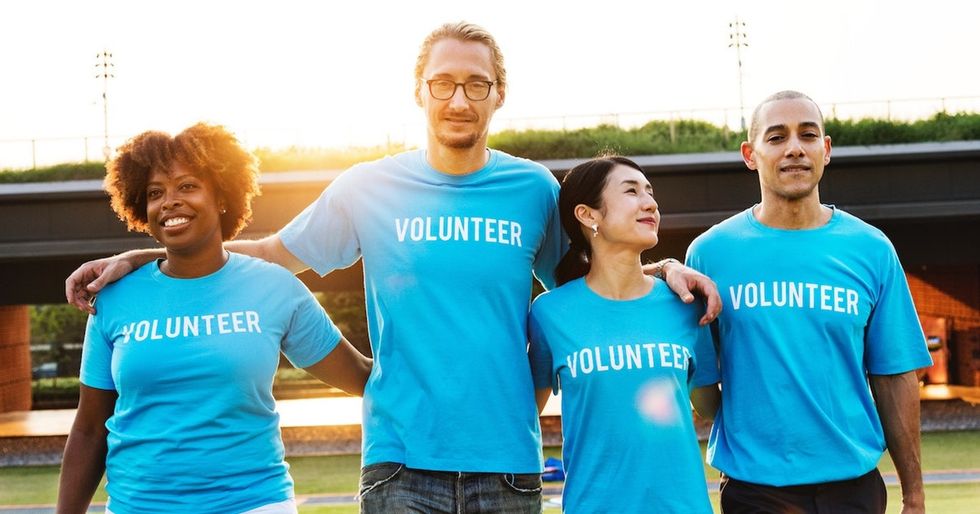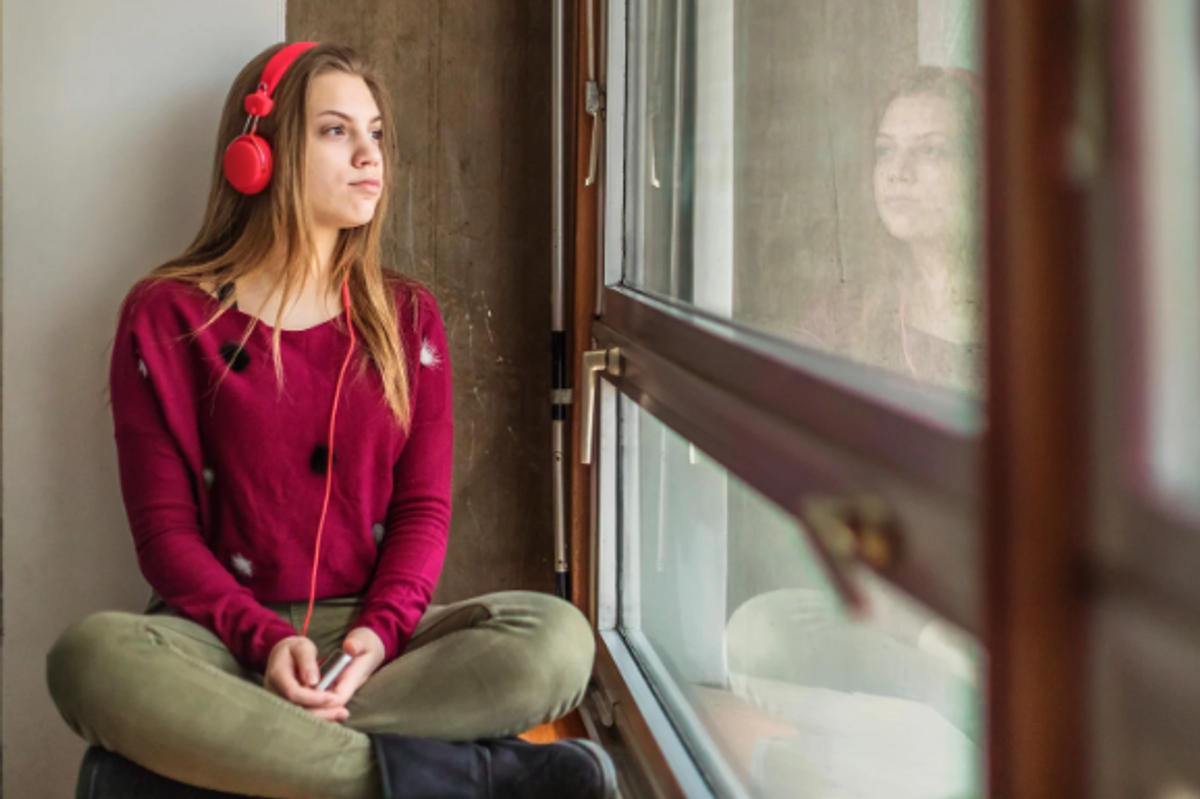Looking to make an impact in your community? These people have some ideas.

We're always talking about giving back to our community. It's important. But sometimes it's hard to figure out where to start.
Volunteering and helping others isn't just good for the people around you, it's good for you, too. However, deciding what you want to do to help make an impact is often the trickiest part. Perhaps you're wondering whether or not the skills you already have can translate into actions that will elevate the lives of those in your neighborhood?
The answer is: Yes. There are endless ways to be an arbiter of change no matter where you live. Below you'll find some great places to start.
Build relationships with young people to help them gain the tools and skills they need to reach their full potential through programs like Thread.

The relationships a child develops early on play a crucial role in their educational and future life successes. Few organizations know that better than Thread in Baltimore Maryland, which has seen first-hand how positive bonds with adults has turned disadvantaged children's lives around.
The basis of their program is simple — as they note on their website: "Thread engages underperforming high school students confronting significant barriers outside of the classroom by providing each one with a family of committed volunteers and increased access to community resources. We foster students' academic advancement and personal growth into self-motivated, resilient, and responsible citizens."
Their methodology seems to be working. Out of all the kids who've been part of Thread for 6 years, 85% have graduated high school, and 83% have completed a two or four year degree or certificate program.
But it's about more than helping students. Thread fervently believes everyone who forms relationships through the program benefits, because we could all use more ties to a community.
Becoming a volunteer is easy — as long as you can connect with a student once a week, you're more than welcome.
Leverage your unique knowledge and skills to help others learn, like Oliver Ballou.
Olivier Ballou is a graphic designer in Washington, D.C.. Through Stand Together's Needs and Offers Marketplace, a volunteer platform that connects people to organizations that can benefit from their skills, he created two infographics for The Nevada Youth Empowerment Project. It's a community-based organization that helps "homeless, aged-out, unprepared, and parentless youths" gain the skills necessary for a limitless future. The program helps youth finish high school, enter college, find jobs, obtain housing, and maintain employment all while building the interpersonal relationships they need to create a strong support network that can offer help if they need it.
For the first project, Monica DuPea, Executive Director at NYEP, was looking for an infographic that could “highlight our breadth of accomplishments and experiences during that time that we can hand out to community members and add to our website for a quick reference for newcomers," She hoped it would "help increase donors and raise awareness about the organization."
The second was a bit more specific. “Each year, NYEP organizes the Washoe County Homeless Youth Count," explained DuPea. "The data collected at these counts is used by our agency and others to tell a story about a single point in time with regards to the Homeless Youth situation. When it comes to data about youth want to be sure that the information is easy to understand and is visually exciting."
Each infographic is estimated to have saved MYEP $4,212 — so Ballou ended up saving them a combined total of over $8,400.
If you're interested in helping youth reach their potential, gain the education they need to live their best life, and fight poverty, NYEP is a great organization to give your time and money to.
Look for ways to reduced barriers in your community through apps like Be My Eyes and programs like The Path Project.
Jennifer Bristol struggled for a long time about how to give back. Not only has she relocated many times in her life — attaching her to "many geographic communities" — but she's also an introvert. Being around others for too long drained her of energy. So while she's always been passionate about helping others, she sometimes found it hard to do.
"I give back to my global community through an app called Be My Eyes," Jennifer writes. "This app connects sighted people with blind people who need assistance with pretty much anything having to do with sight." She's helped people choose items of clothing, read the directions to a recipe, and select the movie they might want to see that night. While they might sound like small things, the help has made a make huge differences to blind people all over the world.
"I find it really satisfying to do something for someone else that I do on a daily basis and take for granted," Jennifer adds. "It's grounding and a great reminder to be grateful for all I have. I also love that it gives the recipients a sense of independence. Instead of one pair of eyes, they have tens of thousands at their disposal."
While the barriers Jennifer helps blind people navigate are often physical, there are other barriers, like a lack of access to education, that are similarly limiting. That's where organizations like The Path Project come in.
The Hollandsworths, who started The Path Project, saw a gap in the educational outcomes of young kids in their neighborhood. Not only were the families that lived there fighting poverty, but language barriers prevented their children from succeeding in school. So they started a volunteer homework helping program that took off in a big way.
The Path Project's success speaks for itself. 95% of its students attend school regularly, 87% have passing grades in reading and math, and 92% have good behavior reports in school.
If you live in Georgia, you can volunteer as a tutor, but there are opportunities to give a hand to kids all over the country through Stand Together's Catalysts — organizations with similar social good goals.
Whether you mentor kids, offer your skills to those in need, or use your eyes to help others see, you're helping others get where they want to go. That's making the world a better place.
Thread, NYEP and The Path Project are able to offer that support to a large community thanks to their partnership with Stand Together, an organization that's helping break the cycle of poverty by supporting the country's most innovative social entrepreneurs.
Stand Together's support allows these organizations to scale their efforts in existing communities and other places that need it.
Want more ideas for how you can help out your community, or the global community? Check out their site to learn about many other organizations that are making a difference and get involved!
To find out which organizations supports your values, take this quiz here and let Stand Together do the searching for you.


 Photo by
Photo by  Photo by
Photo by  Photo by
Photo by 
 Millennial mom struggles to organize her son's room.Image via Canva/fotostorm
Millennial mom struggles to organize her son's room.Image via Canva/fotostorm Boomer grandparents have a video call with grandkids.Image via Canva/Tima Miroshnichenko
Boomer grandparents have a video call with grandkids.Image via Canva/Tima Miroshnichenko


 Information from the NICABM website regarding the "Window of Tolerance."Photo Credit: The National Institute for the Clinical Application of Behavioral Medicine
Information from the NICABM website regarding the "Window of Tolerance."Photo Credit: The National Institute for the Clinical Application of Behavioral Medicine  Waves cycle in the ocean. Photo by
Waves cycle in the ocean. Photo by
Gen Xers and Millennials share 17 of the strangest things their Baby Boomer parents do
"My mom writes her emails in MS Word, then attaches the Word document to the email."
A Baby Boomer couple.
Generational fights have raged since the dawn of time, and a recent spat between Millennials and Baby Boomers is no exception. Baby Boomers, who raised Millennials, accuse the younger generation of being entitled and irresponsible with money. At the same time, Millennials accuse Boomers of having it easier economically while making it harder for those who came after them.
Where is Gen X in the battle? Probably off in the corner somewhere, saying, "Whatever." Aside from the generational sniping, there are some things the older generation does that are just plain baffling to younger people. Whether it's outdated worldviews, a refusal to adapt to modern technology, or a lack of self-awareness, Baby Boomers can do some strange things.
To help the younger folks get over their frustrations with parents from the "Me Generation," a Redditor asked: "What is the most Boomer thing your parents still do?" The stories were pretty funny and relatable, showing that almost everyone with parents over 60 is dealing with the same thing.
Here are 17 of the "strangest" things people's Baby Boomer parents do:
1. Phones on full blast
"Play iPhone slot machine games at full volume in the doctor’s office."
"My dad pretty much exclusively has his phone on speaker, and just walks around in public talking with it at max volume (and talking really loud himself). I’m like 'Dad, the entire supermarket doesn’t want to listen to you, and Uncle Jim complains about how often you have to pee.'"
2. Still using checkbooks
"My mom balances her checkbook every week. They still have a landline."
"And she probably has way more money than you will until she dies!"
3. Email issues
"My mom writes her emails in MS Word, then attaches the Word document to the email."
"Like the email is just the virtual envelope for the digital letter."
4. Restaurant jokes
"All those little restaurant comments.
'Wow, they'll let anyone in here!' when seeing a friend at said restaurant.
'Thanks for having us, not everyone will' to the waiter at the end of the meal.
'As you can see, it was terrible' when the staff takes away the clearly entirely eaten plate.
'You're going to have me floating away in a minute' when more water is put into their glass"
5. Always have to mention race
"Constantly mentioning the race or ethnicity of everyone she mentions. Never with any negative connotation or comment, but usually, there is no reason for it to be relevant to the conversation."
"My Jewish mother will always whisper the word 'black' in case anyone hears her: 'So the nice black man at the hardware store helped me find the right garden hose.'"
6. Googling their Google
"Typing Google on Google before they Google the thing they’re looking for."
"In the Google search bar, they type Google? Lol."
7. Getting a job is a cinch
"Believing you can walk into a business and hand in a resume. If you have a college degree in any field, they'll hire you."
"Just physically hand over your resume to HR or the hiring manager. You'll make a mark and get hired!! Call the office and ask to speak to HR/Hiring Manager."
Any Millennial who argued with their Boomer parents about how hard it is to land a good job should feel vindicated by a 2022 study, which found that most older Millennials didn't secure good jobs until their early 30s, while most Boomers did so in their 20s. "To secure a good job, young adults need to acquire more education and high-quality work experience than was necessary for previous generations," the researchers wrote.
8. Why are they together?
"Stay married forever while they behave like neither one of them can stand each other."
"I'm on the other side of that. After my mom passed, my dad now acts like their marriage was picture perfect and they were the love of each other's lives, even though they couldn't stand each other for at the very least 40 of the 54 years they were married."
9. Collectables or hoarding?
"Think their 'collectibles' are truly valuable."
"My mom insists her Hummels are going to put my kids through college!"
"Mine are the Thomas Kincade paintings. She has a Victorian glass piece that might actually be worth something, but those damn paintings are the real investment."
10. Can you grab the mail?
"Ask me to bring in the mail when they go away for more than 24 hours."
"My parents think everybody is standing at the door waiting for the mailman every day, and don’t believe me when I tell them that some people go days without checking their mail. They think everybody is waiting for the mailman every day because 'somebody might send them a check.' Like, really?"
11. Zero responsibility
"'Well, I guess I was just a bad father.' Yeah. That attitude of anti-responsibility is exactly why 3 out of 4 of your children don't talk to you."
"Ha! Have the same dad, do we?"
12. Comment on people's appearance
"Comment on EVERYBODY’s body/appearance/weight. The first thing my dad does after not seeing me for a year is poke me in the gut and tell me how fat I am."
13. Boomer panic is real
"Literally throwing their hands up in a panic when they don't understand something. Where did they learn that?"
"Or just saying 'well, I don't know', especially when that comes right after you explaining it and showing them how to do something, with them nodding along and asking relevant questions all the way through."
In a video by YourTango, editor Brian Sundholm tried to explain Boomer panic in an empathetic way: "Most of us nowadays know the importance of recognizing and feeling our emotions." Sundholm then quoted therapist Mitzi Bachman, who explained that when people struggle to express their emotions, it can result in an "unhinged" reaction.
14. Annoying Facebook posts
"Post nonsensical rants on Facebook for other boomers to like, share, and comment. Often these rants are political, but not always. Basically cringe-fest."
"Most people won't do it, but share this post if you believe in god and freedom."
"I do NOT give Facebook permission to use my photos and personal information!"
15. Dinner pushers
"While we're eating breakfast. What do you want to do for supper?"
"Can't we enjoy this meal without worrying about the next?"
16. They print everything
"My boomer in-laws print EVERYTHING! The number of times I have said, 'quit wasting ink, email it to me, or text me the link. Or just text me the schedule, don't print it out.' GPS on their phones? Nope...print a map."
"Boomers and their paper man. My dad has finally started using the internet, but he still prints everything he likes. Like he'll see a boat listing on Craigslist and print the entire page, including a massive color photo of it, and he's definitely not going to be buying it either. He's got a stack of papers that is the internet that sits by his recliner. He just sits there with Fox News on (though it's usually muted for some reason, that's a plus) and looks at his papers."
17. Flirting with servers
"My dad is 77 still flirts with the young waitresses. It's f**king weird for everyone."
"He thinks he is in cute old man territory, but he is not."